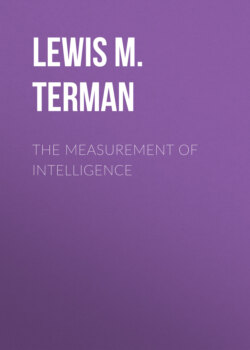Читать книгу The Measurement of Intelligence - Lewis M. Terman - Страница 26
На сайте Литреса книга снята с продажи.
How the scale was derived.
ОглавлениеTable of Contents
The tests were arranged in order of difficulty, as found by trying them upon some 200 normal children of different ages from 3 to 15 years. It was found, for illustration, that a certain test was passed by only a very small proportion of the younger children, say the 5-year-olds, and that the number passing this test increased rapidly in the succeeding years until by the age of 7 or 8 years, let us say, practically all the children were successful. If, in our supposed case, the test was passed by about two thirds to three fourths of the normal children aged 7 years, it was considered by Binet a test of 7-year intelligence. In like manner, a test passed by 65 to 75 per cent of the normal 9-year-olds was considered a test of 9-year intelligence, and so on. By trying out many different tests in this way it was possible to secure five tests to represent each age from 3 to 10 years (excepting age 4, which has only four tests), five for age 12, five for 15, and five for adults, making 54 tests in all.
